Abstract
The N and O substitution in wall peptidoglycan from Lactobacillus fermentum was studied in relation to growth phase, as well as the lytic activities and the effect of trypsin on them. The N-nonsubstituted sites were determined by dinitrophenylation techniques. The results indicate that an extensive substitution at the O groups takes place as cells go into the stationary growth phase, concomitant with a decrease in their lysozyme sensitivity. N-nonsubstituted residues, mainly glucosamine, occurred in both exponential-phase and stationary-phase walls but not in the corresponding peptidoglycans. Small amounts of N-nonsubstituted muramic acid were detected in walls and peptidoglycan from cells in the stationary growth phase only. N acetylation of isolated walls did not increase their lysozyme sensitivity but rather decreased it. Autolysis of walls was completely inhibited by the chemical modifications used. Trypsin stimulates the lysozyme sensitivity of native walls but has no effect on walls that had been O deacetylated and N acetylated. It is suggested that the effect of trypsin is due to its action as an esterase removing the O acetylation in lysozyme-resistant walls.
Full text
PDF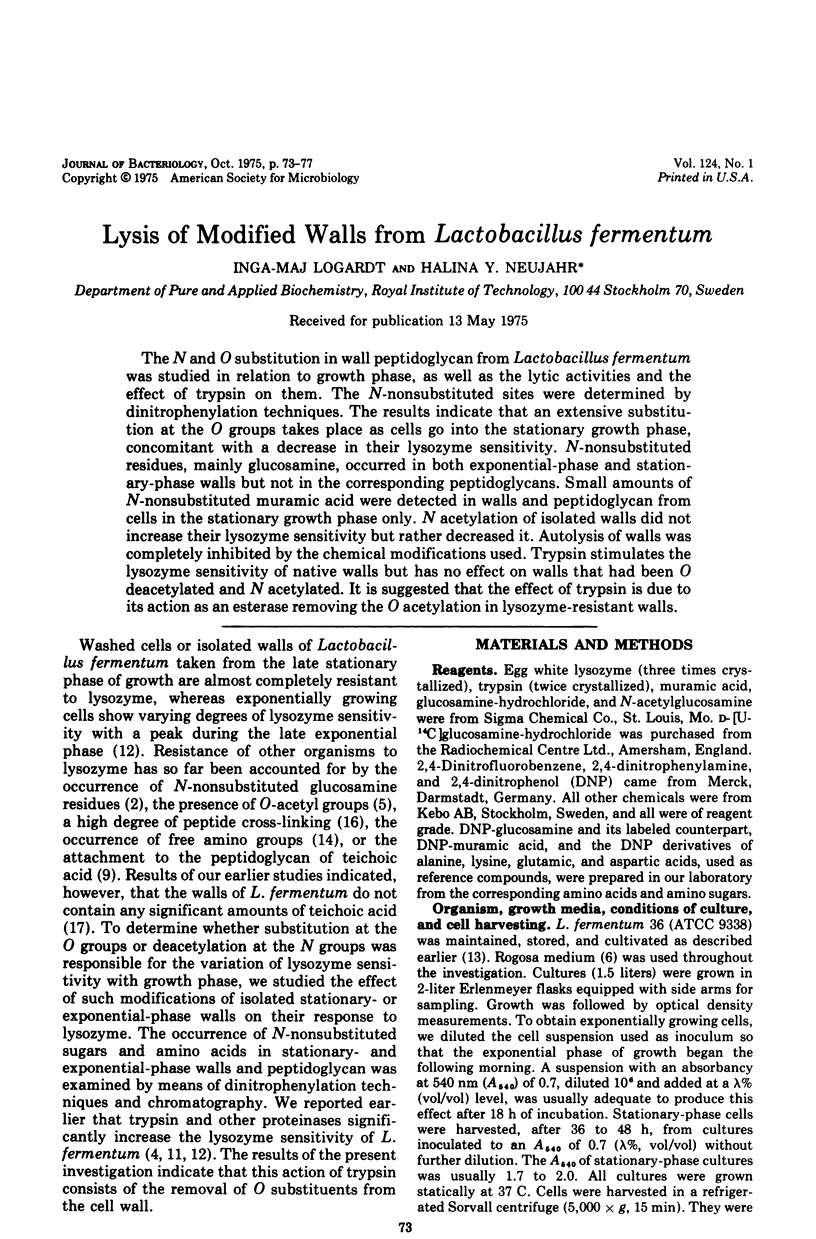
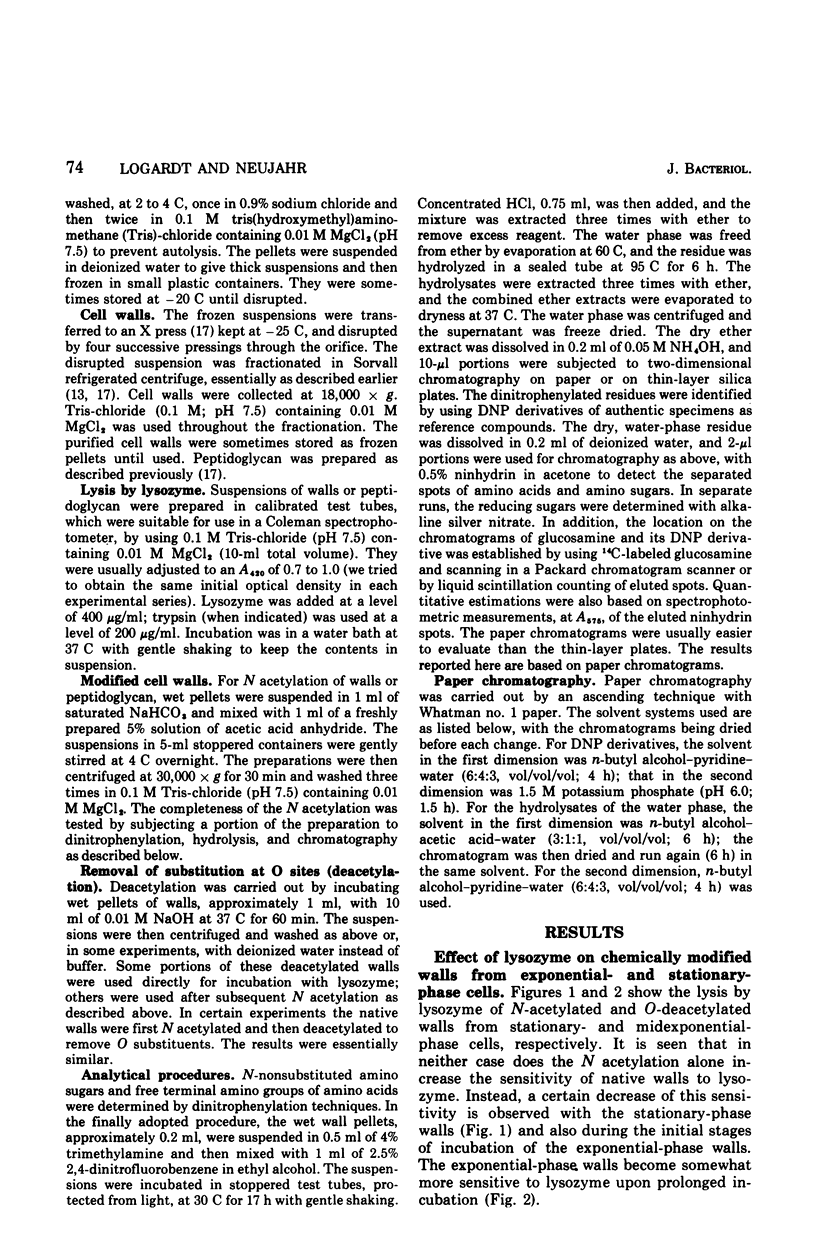
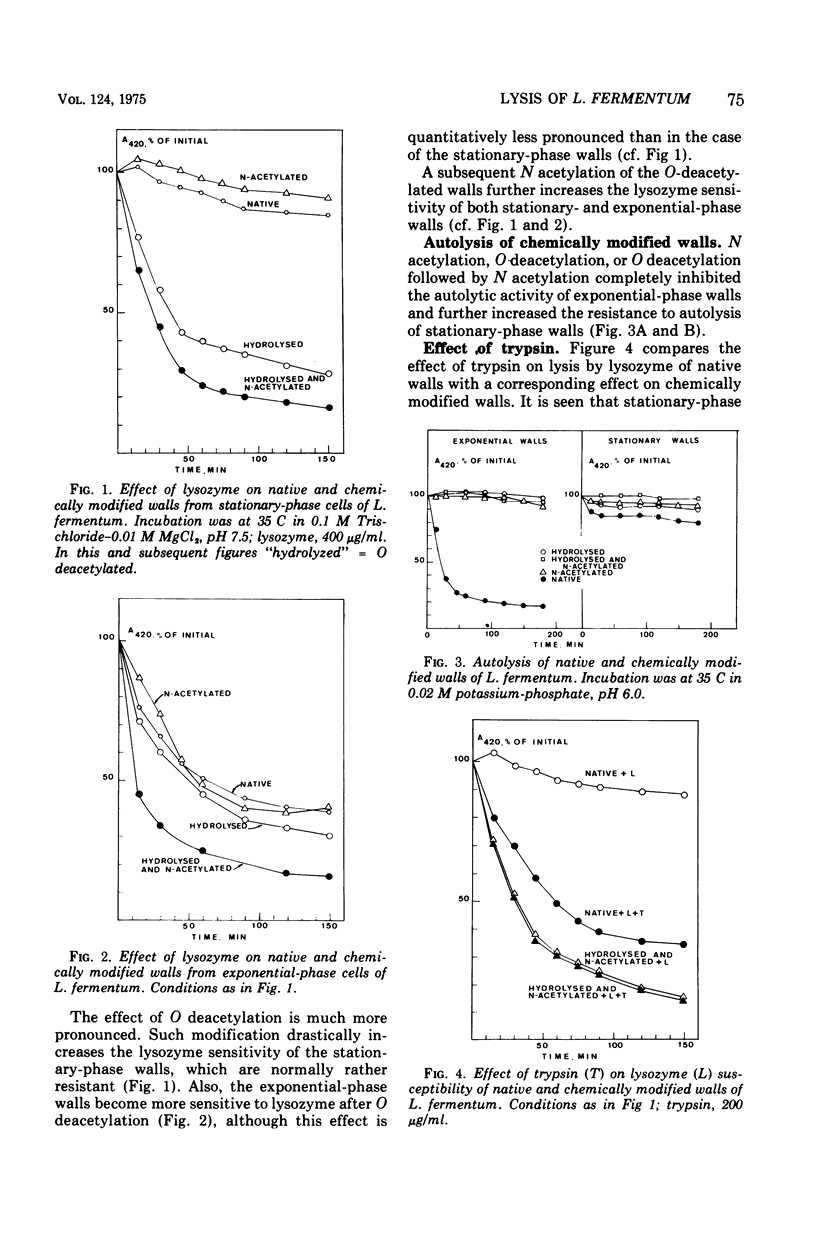
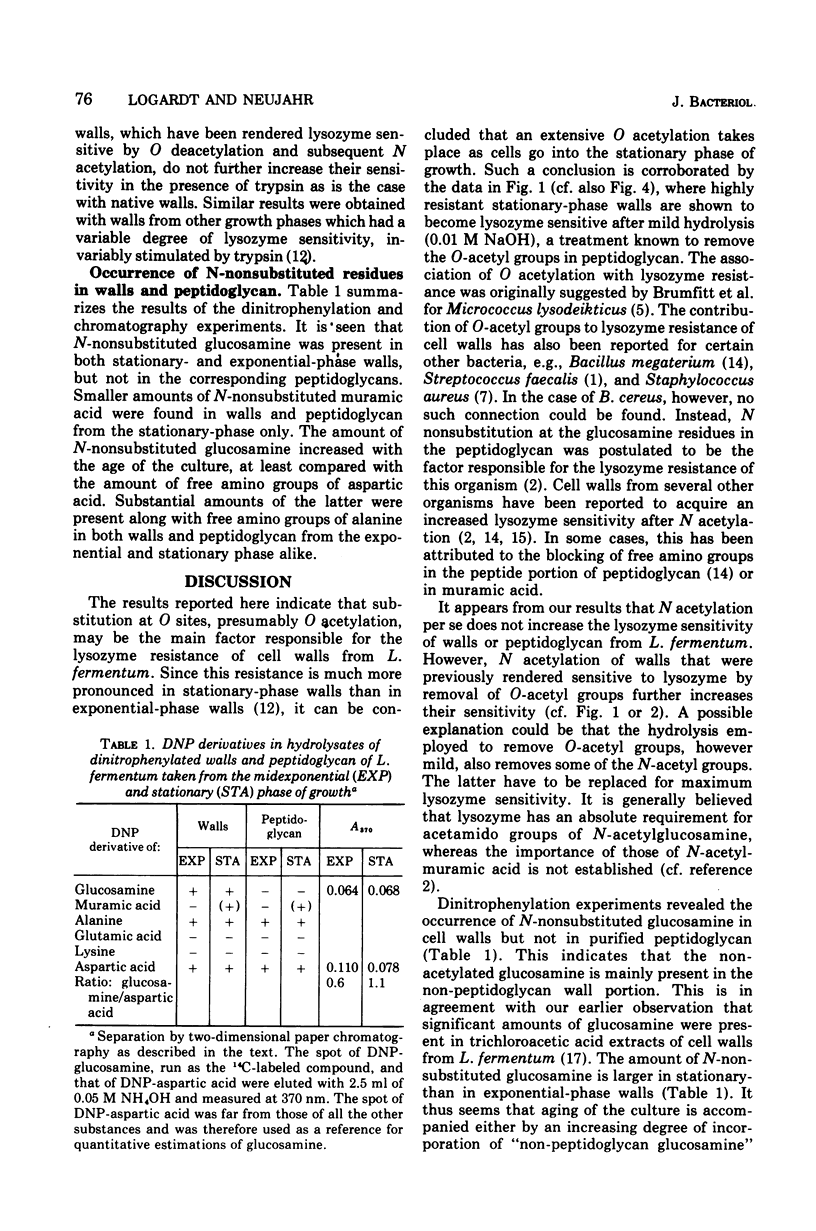
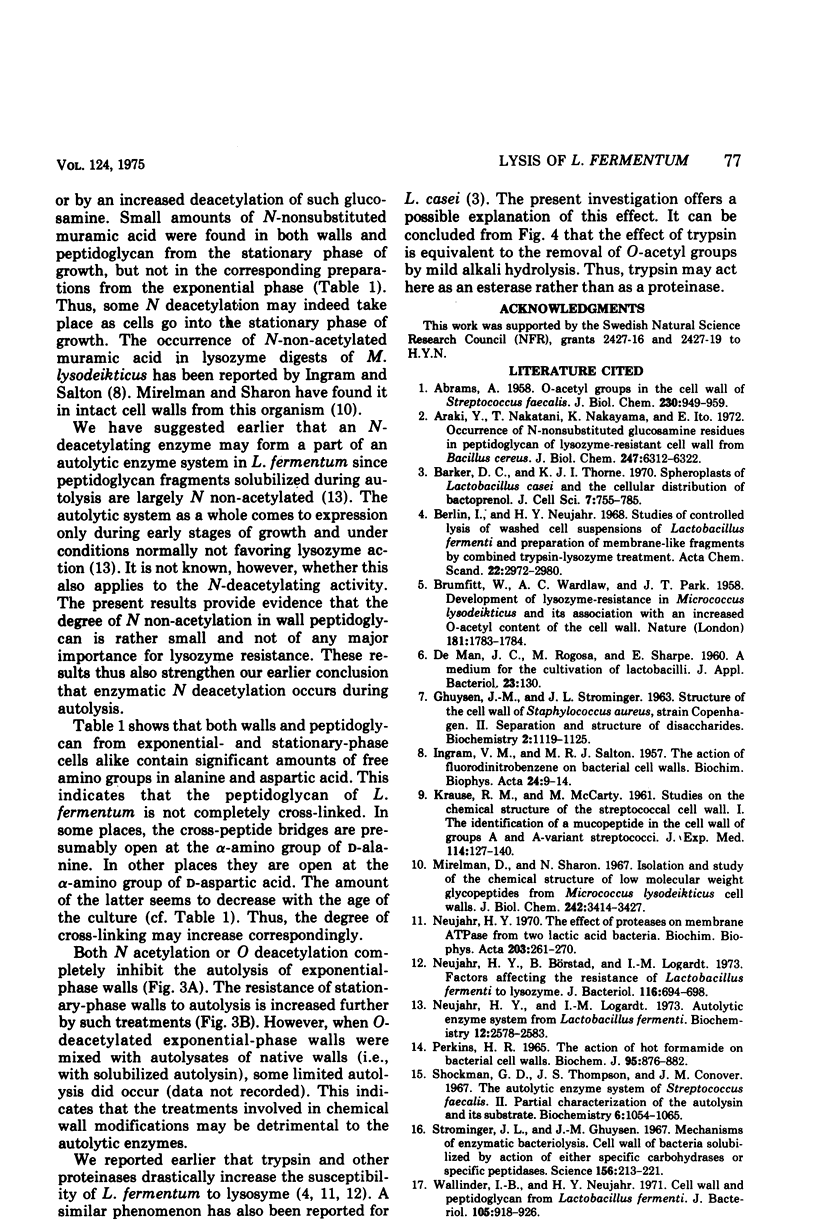
Selected References
These references are in PubMed. This may not be the complete list of references from this article.
- ABRAMS A. O-acetyl groups in the cell wall of Streptococcus faecalis. J Biol Chem. 1958 Feb;230(2):949–959. [PubMed] [Google Scholar]
- Araki Y., Nakatani T., Nakayama K., Ito E. Occurrence of N-nonsubstituted glucosamine residues in peptidoglycan of lysozyme-resistant cell walls from Bacillus cereus. J Biol Chem. 1972 Oct 10;247(19):6312–6322. [PubMed] [Google Scholar]
- BRUMFITT W., WARDLAW A. C., PARK J. T. Development of lysozyme-resistance in Micrococcus lysodiekticus and its association with an increased O-acetyl content of the cell wall. Nature. 1958 Jun 28;181(4626):1783–1784. doi: 10.1038/1811783a0. [DOI] [PubMed] [Google Scholar]
- Barker D. C., Thorne K. J. Spheroplasts of Lactobacillus casei and the cellular distribution of bactoprenol. J Cell Sci. 1970 Nov;7(3):755–785. doi: 10.1242/jcs.7.3.755. [DOI] [PubMed] [Google Scholar]
- Berlin I., Neujahr H. Y. Studies of controlled lysis of washed cell suspensions of Lactobacillus fermenti and preparation of membrane-like fragments by a combined trypsin-lysozyme treatment. Acta Chem Scand. 1968;22(9):2972–2980. doi: 10.3891/acta.chem.scand.22-2972. [DOI] [PubMed] [Google Scholar]
- GHUYSEN J. M., STROMINGER J. L. STRUCTURE OF THE CELL WALL OF STAPHYLOCOCCUS AUREUS, STRAIN COPENHAGEN. II. SEPARATION AND STRUCTURE OF DISACCHARIDES. Biochemistry. 1963 Sep-Oct;2:1119–1125. doi: 10.1021/bi00905a036. [DOI] [PubMed] [Google Scholar]
- INGRAM V. M., SALTON M. R. The action of fluorodinitrobenzene on bacterial cell walls. Biochim Biophys Acta. 1957 Apr;24(1):9–14. doi: 10.1016/0006-3002(57)90139-7. [DOI] [PubMed] [Google Scholar]
- KRAUSE R. M., MCCARTY M. Studies on the chemical structure of the streptococcal cell wall. I. The identification of a mucopeptide in the cell walls of groups A and A-variant streptococci. J Exp Med. 1961 Jul 1;114:127–140. doi: 10.1084/jem.114.1.127. [DOI] [PMC free article] [PubMed] [Google Scholar]
- Neujahr H. Y., Börstad B., Logardt I. M. Factors affecting the resistance of Lactobacillus fermenti to lysozyme. J Bacteriol. 1973 Nov;116(2):694–698. doi: 10.1128/jb.116.2.694-698.1973. [DOI] [PMC free article] [PubMed] [Google Scholar]
- Neujahr H. Y., Logardt I. M. Autolytic enzyme system from Lactobacillus fermenti. Biochemistry. 1973 Jul 3;12(14):2578–2583. doi: 10.1021/bi00738a005. [DOI] [PubMed] [Google Scholar]
- Neujahr H. Y. The effect of proteases on membrane ATPase from two lactic acid bacteria. Biochim Biophys Acta. 1970 Apr 21;203(2):261–270. doi: 10.1016/0005-2736(70)90140-9. [DOI] [PubMed] [Google Scholar]
- PERKINS H. R. THE ACTION OF HOT FORMAMIDE ON BACTERIAL CELL WALLS. Biochem J. 1965 Jun;95:876–882. doi: 10.1042/bj0950876. [DOI] [PMC free article] [PubMed] [Google Scholar]
- Shockman G. D., Thompson J. S., Conover M. J. The autolytic enzyme system of Streptococcus faecalis. II. Partial characterization of the autolysin and its substrate. Biochemistry. 1967 Apr;6(4):1054–1065. doi: 10.1021/bi00856a014. [DOI] [PubMed] [Google Scholar]
- Strominger J. L., Ghuysen J. M. Mechanisms of enzymatic bacteriaolysis. Cell walls of bacteri are solubilized by action of either specific carbohydrases or specific peptidases. Science. 1967 Apr 14;156(3772):213–221. doi: 10.1126/science.156.3772.213. [DOI] [PubMed] [Google Scholar]
- Wallinder I. B., Neujahr H. Y. CELL WALL AND PEPTIDOGLYCAN FROM Lactobacillus fermenti. J Bacteriol. 1971 Mar;105(3):918–926. doi: 10.1128/jb.105.3.918-926.1971. [DOI] [PMC free article] [PubMed] [Google Scholar]


